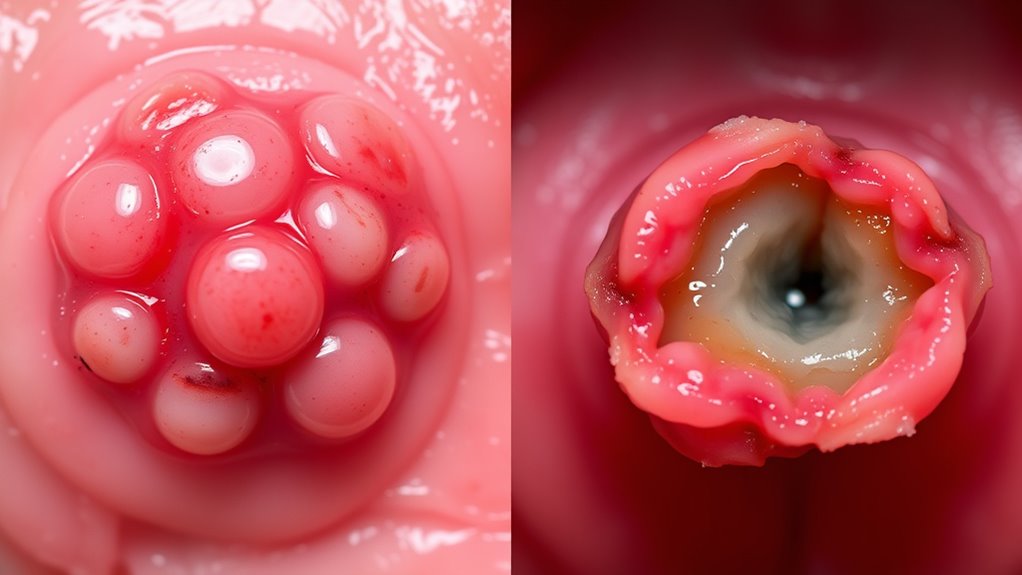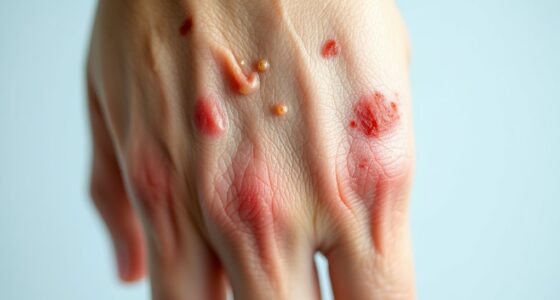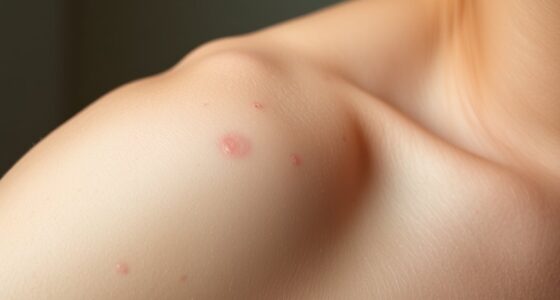Cold sores, caused by herpes simplex virus, appear as contagious blisters on or around your lips, usually last about a week, and may flare up with triggers like stress or sun exposure. Canker sores, on the other hand, are non-contagious ulcers inside your mouth, often painful but heal within two weeks without scabbing. Understanding their causes, locations, and treatments can help you manage them better—exploring further can give you a clearer picture of how to handle each one.
Key Takeaways
- Cold sores are caused by herpes simplex virus and appear on or around lips, while canker sores are non-contagious ulcers inside the mouth.
- Cold sores typically form blisters that crust over, whereas canker sores are painful ulcers without blisters.
- Cold sores are contagious and transmitted via saliva, unlike canker sores, which are not contagious.
- Cold sores usually last 7-10 days and are visible externally, while canker sores heal in 1-2 weeks and are hidden inside the mouth.
- Treatment for cold sores includes antiviral medications, whereas canker sores are managed with topical anesthetics and good oral hygiene.
Causes and Origins

Cold sores are caused by the herpes simplex virus (typically HSV-1), which becomes active after initial infection and remains dormant in your nerve cells. You usually catch HSV-1 through direct contact with an infected person’s saliva, such as kissing or sharing utensils. Once infected, the virus hides in your nerve tissues, often without causing symptoms. Certain triggers, like stress, illness, sun exposure, or a weakened immune system, can activate the virus, leading to cold sore outbreaks. It’s important to understand that you can transmit the virus even when no sore is visible, making it highly contagious. After the initial infection, the virus stays with you for life, with outbreaks occurring intermittently. AI security research continues to explore ways to better understand and manage viral behaviors and containment.
Symptoms and Appearance

When an outbreak occurs, you’ll notice specific signs that distinguish cold sores from other oral issues. Cold sores typically start with a tingling or itching sensation on or around your lips, followed by small, fluid-filled blisters that cluster together. These blisters are often red and swollen, and they can burst, forming crusted, scabby sores as they heal. In contrast, canker sores appear as small, round or oval ulcers inside your mouth, usually with a white or yellowish center and a red halo. Canker sores don’t usually cause blisters or swelling and are confined to the soft tissues inside your mouth. Recognizing these differences helps you identify the issue quickly and seek appropriate treatment. Additionally, understanding the seasonal variations can help you anticipate outbreaks and take preventive measures.
Typical Locations in the Mouth

Cold sores tend to appear on or around your lips, often at the edges or border of the mouth, making them highly visible. You might notice small blisters that eventually turn into crusted sores, usually causing discomfort or tingling before they emerge. These sores can also appear inside your nose or on your chin, but they rarely occur deep inside the mouth. In contrast, canker sores develop inside your mouth, usually on the soft tissues like the inside of your cheeks, gums, or the roof of your mouth. Unlike cold sores, they aren’t on the lips or external areas. Canker sores are usually round or oval with a white or yellow center and red border, and they tend to be hidden within the oral cavity rather than on the lips’ surface. Unique and wicked planters are unrelated to these conditions but highlight the importance of understanding different health and safety factors in various contexts.
Duration and Healing Process

The duration and healing process for cold sores and canker sores differ markedly. Cold sores typically last 7 to 10 days, going through stages like blistering, oozing, and crusting before healing. You might notice a tingling sensation before blisters appear, and discomfort can persist during this period. Canker sores, on the other hand, usually heal within 1 to 2 weeks without scarring. They often start as small, painful ulcers that gradually reduce in size and discomfort. Unlike cold sores, canker sores aren’t contagious and tend to resolve on their own. During healing, you may experience some residual soreness, but the sores generally don’t leave lasting marks. Your body’s immune response plays a significant role in how quickly each sore heals. Proper oral hygiene and avoiding irritants can also facilitate faster recovery from mouth ulcers.
Treatment and Prevention Strategies

Effective treatment and prevention strategies can help minimize discomfort and reduce the frequency of outbreaks for both cold sores and canker sores. For cold sores, antiviral medications like acyclovir or valacyclovir can speed up healing and lower recurrence chances. Applying over-the-counter creams such as docosanol provides relief and shortens outbreaks. To prevent cold sores, avoid close contact with infected individuals and manage stress, which can trigger outbreaks. For canker sores, topical anesthetics and antimicrobial mouthwashes can ease pain and promote healing. Maintaining good oral hygiene, reducing stress, and avoiding irritating foods also help prevent future sores. Staying well-hydrated and ensuring a balanced diet supports overall oral health. Regular dental check-ups can catch issues early and guide you on effective prevention.
Frequently Asked Questions
Can Cold Sores Spread to Other Parts of the Body?
Yes, cold sores can spread to other parts of your body if you touch the sore and then touch other areas. You might transfer the virus to your eyes, fingers, or other skin. To prevent spreading, avoid touching the sore, wash your hands frequently, and don’t share items like towels or lip products. Keep the sore clean and avoid physical contact until it heals to protect yourself and others.
Are Canker Sores Contagious Through Sharing Utensils?
Your concern is valid, but canker sores aren’t contagious through sharing utensils. These sores are caused by factors like stress, injuries, or certain foods, not by viruses. Unlike cold sores, they don’t spread easily. So, you don’t have to worry about a tiny, invisible army of germs hitching a ride on your cutlery. Just avoid irritating your sores with sharp utensils, and they’ll heal faster without spreading.
Do Lifestyle Changes Prevent Cold Sores or Canker Sores?
Lifestyle changes can help prevent cold sores, especially if you’re prone to outbreaks, by reducing stress, avoiding excessive sun exposure, and maintaining good hygiene. For canker sores, improving your diet, managing stress, and avoiding irritating foods may help prevent them. While these changes can lessen the chances of outbreaks, they might not fully prevent them, so it’s essential to stay vigilant and consult a healthcare professional for persistent issues.
Can Stress Trigger Both Cold Sores and Canker Sores?
You wanna know if stress can trigger both cold sores and canker sores? The answer is yes. Stress weakens your immune system, making you more vulnerable to cold sores caused by the herpes virus and canker sores triggered by emotional or physical strain. When you’re stressed, your body struggles to fight off infections and heal, increasing the chances of both types of sores appearing. Managing stress helps protect your oral health.
Are There Any Long-Term Health Risks Associated With Either Sore?
You ask about long-term health risks from sores. While cold sores, caused by the herpes virus, can sometimes lead to complications like herpetic keratitis or rare brain issues, these are uncommon. Canker sores typically don’t cause lasting problems but can be linked to nutritional deficiencies or underlying health conditions. If sores persist or recur frequently, it’s best to see a healthcare professional to rule out more serious issues.
Conclusion
Remember, knowing the differences between cold sores and canker sores helps you respond effectively. While cold sores are caused by a virus and may require antiviral treatments, canker sores are usually related to stress or injury and often heal on their own. Don’t worry if they seem similar—understanding their causes and symptoms guarantees you get the right care. Trust that with proper treatment and prevention, you can manage both types comfortably and confidently.









